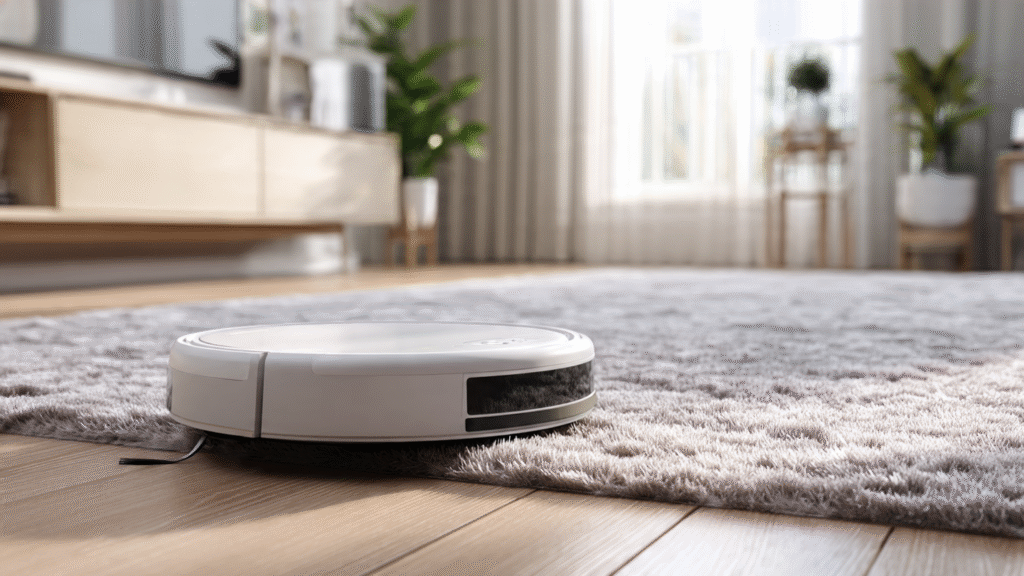Robot vacuums have transformed modern cleaning by taking the effort out of daily floor maintenance. In 2025, these smart devices are smarter, faster, and more efficient than ever. But with so many models on the market, how do you choose the best robot vacuum for your needs?

This comprehensive robot vacuum buying guide for 2025 will walk you through the key features, types, pros and cons, and answers to common questions so you can make the right choice for your home.
Why Buy a Robot Vacuum in 2025?
Before we dive into details, here are the main reasons homeowners in 2025 are switching to robot vacuums:
- Convenience: Hands-free cleaning while you work, travel, or relax.
- Smart Technology: AI-powered mapping, app control, and voice assistant compatibility.
- Efficiency: Cleans under furniture and in tight spaces where traditional vacuums struggle.
- Time Saving: Automates daily cleaning, reducing the need for manual vacuuming.
- Improved Models: Better suction power, longer battery life, and advanced navigation compared to older versions.
Types of Robot Vacuums
When shopping for a robot vacuum, it helps to know the different types available:
- Basic Robot Vacuums
- Affordable models with random cleaning patterns.
- Best for small apartments or occasional use.
- Mid-Range Smart Vacuums
- Offer mapping, stronger suction, and app control.
- Good balance between price and performance.
- High-End AI Robot Vacuums
- Advanced mapping, obstacle detection, and smart home integration.
- Ideal for large homes, pets, and frequent use.
- Robot Vacuum & Mop Combos
- 2-in-1 machines that vacuum and mop simultaneously.
- Great for homes with mixed floor types.
Key Features to Consider in 2025
When comparing models, keep these important features in mind:
- Suction Power: Measured in Pa (Pascal units). Higher suction means better cleaning for carpets and pet hair.
- Battery Life & Charging: Look for at least 90–120 minutes of runtime and auto-return to charging dock.
- Navigation System:
- Gyroscope/Random → budget models.
- Lidar & AI cameras → precise mapping, avoids obstacles like cables and furniture.
- Dustbin Size: Larger bins mean less frequent emptying.
- Self-Emptying Dock: Premium feature where the robot empties itself into a larger container.
- Noise Levels: Quiet operation matters if you’ll run it while at home.
- Smart Home Compatibility: Works with Alexa, Google Assistant, or Siri.
- Mopping Functionality: Optional, but great for tile or hardwood floors.
Best Robot Vacuum Brands in 2025
- iRobot Roomba – Reliable, user-friendly, advanced models with self-emptying docks.
- Roborock – Known for powerful suction and mop-vacuum combos.
- Ecovacs Deebot – Excellent mapping and versatile cleaning modes.
- Eufy (by Anker) – Budget-friendly with solid performance.
- Shark AI Vacuums – Strong suction and self-emptying options.
Pros and Cons of Robot Vacuums
Pros:
- Saves time and effort
- Cleans daily without supervision
- Reaches under furniture
- Smart scheduling via apps
Cons:
- Higher upfront cost than traditional vacuums
- Smaller dustbins require frequent emptying (unless self-emptying model)
- Can struggle with very thick carpets
- Requires maintenance (filter cleaning, brush untangling)
Best Robot Vacuum for Different Needs
- For Pet Owners: Roborock S8 Pro Ultra, iRobot Roomba j7+
- For Large Homes: Ecovacs Deebot X2 Omni
- For Budget Buyers: Eufy RoboVac 11S
- For Hardwood Floors: Roborock Q7 Max+ with mop function
- For Busy Families: Shark AI Ultra with self-emptying base
Robot Vacuum FAQs
Do robot vacuums replace traditional vacuums?
Not entirely. They’re excellent for daily cleaning but may not fully replace deep-cleaning vacuums.
How often should I run my robot vacuum?
Most people schedule it once a day or every other day depending on foot traffic and pets.
Are robot vacuums worth the money in 2025?
Yes. With AI mapping, stronger suction, and self-emptying docks, they’re more efficient than ever.
Can robot vacuums work on carpets?
Yes, most mid-range and high-end models handle low to medium-pile carpets well.
How much should I spend on a good robot vacuum?
- Budget models: $150–$250
- Mid-range: $300–$600
- Premium AI models: $700–$1,200+
Final Buying Guide Checklist
Before purchasing a robot vacuum in 2025, ask yourself:
- What’s my budget?
- Do I need a self-emptying dock?
- Do I have pets or kids (more dirt, more suction needed)?
- Is my home mostly hardwood, carpet, or mixed floors?
- Do I prefer AI mapping or a basic random cleaner?
Conclusion
Buying a robot vacuum in 2025 is about matching the right features to your lifestyle and home. Whether you want a budget-friendly daily helper or a premium AI-powered cleaning assistant, today’s models offer more power, convenience, and intelligence than ever before. Aslo, read about Best Noise Cancelling Headphones for Travel in 2025: Top Picks & Buyer’s Guide if you are interested.
👉 Our top pick for 2025: Roborock S8 Pro Ultra for its balance of power, mapping, and 2-in-1 cleaning.
Disclaimer: This article is for informational purposes only. Product features and availability may change over time. Always check official specifications before purchasing.